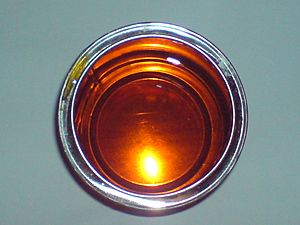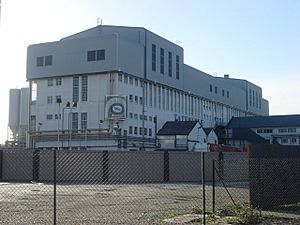Golden syrup facts for kids

Golden syrup's characteristic amber colour
|
|
| Alternative names | Light treacle |
|---|---|
| Place of origin | England |
| Main ingredients | Refined sugar cane or sugar beet juice |
Golden syrup is a thick, golden-colored syrup. It is also known as light treacle. This sweet syrup is made from sugar cane or sugar beet juice. It is a special type of inverted sugar syrup, which means its sugar molecules have been changed.
Golden syrup is very popular in baking and desserts. It looks and feels a lot like honey. People often use it when honey isn't available or is too expensive. It's important not to confuse it with other syrups like corn syrup or dark treacle (molasses), which have a stronger taste and darker color.
Lyle's Golden Syrup was first sold in cans in 1885. It was created by chemists Charles Eastick and his brother John Joseph Eastick. They worked at the Abram Lyle & Sons refinery in London, England. In 2006, Guinness World Records said it had the world's oldest brand and packaging!
Contents
The Story of Golden Syrup
The story of golden syrup began in 1863. A man named Abram Lyle owned a business that made barrels. He became the owner of a sugar refinery in Greenock, Scotland. There, he noticed that a thick syrup was left over when sugar was made. This syrup was usually sold cheaply as food for pigs.
Abram Lyle believed this leftover syrup could be made good enough for people to eat. His company grew, and he expanded his business to London.
In 1883, Charles Eastick, a chemist, worked at Abram Lyle & Sons. He found a way to refine the bitter, dark syrup. He and his brother John Joseph Eastick experimented. They turned this waste product into a delicious syrup. It had the same thickness, color, and sweetness as honey. This new product was first sold in 1885 as "golden syrup."
The famous golden syrup tin has a picture of a dead lion with a swarm of bees inside it. The slogan says, "Out of the strong came forth sweetness." This comes from a story in the Bible, from the Book of Judges. In the story, Samson kills a lion. Later, he finds that bees have made honey inside the lion's body.
No one knows exactly why this image was chosen. But Abram Lyle was a very religious man. Some people think it shows the strength of the Lyle company. Others think it refers to the strong tins the syrup comes in. In 1904, the image and slogan became a registered trademark. In 2006, Guinness World Records confirmed it was the world's oldest branding. Lyle's golden syrup also received a Royal Warrant in 1911. This means it was approved for use by the British Royal Family.
In 1921, Lyle's business joined with Tate, another sugar company. They became Tate & Lyle. Later, in 2010, Tate & Lyle sold its sugar and golden syrup business to American Sugar Refining.
How Golden Syrup is Made
Golden syrup contains two types of sugar: glucose and fructose. These sugars dissolve in water more easily than regular sugar (sucrose). This means golden syrup is less likely to turn into hard crystals. Also, the fructose makes the syrup taste sweeter than white sugar. So, you can use less golden syrup for the same sweetness.
The word "invert" comes from how sugar syrups are tested. When light passes through pure sugar water, it turns a certain way. But when the sugar changes into a mix of sucrose, fructose, and glucose, the light turns the opposite way. It's like the direction has "inverted."
Making Golden Syrup at Home
You can make golden syrup at home if you can't find it in stores. You mix water and sugar over heat until it boils. A little citric acid is added. This helps change the sugar into glucose and fructose. The mixture then boils slowly without stirring. It gets thick and turns a golden color. This process also creates other chemicals that give it its unique taste and color.
Commercial Production
Large factories make golden syrup from sugar cane or sugar beet.
For sugar cane, they start with a thick syrup from white sugar refining. This syrup helps wash raw sugar crystals. The leftover syrup from this washing process is then used to make golden syrup. Sometimes, half of this syrup is changed into fructose and glucose. This keeps the syrup liquid and stops it from crystallizing.
Golden syrup can also be made from sugar beet. The beet juice is cleaned and partly evaporated. Then, the main sugar (sucrose) is broken down into glucose and fructose. This can be done using acid or an enzyme called invertase. This makes a smooth syrup that won't crystallize. If acid is used, a small amount of salt is added to make it neutral.
Where to Find Golden Syrup
Golden syrup is sold all over the world. It can be made from either sugar cane or sugar beet.
Lyle's Golden Syrup is a very famous brand in the UK. Other companies like British Sugar (with its Silver Spoon brand) and Ragus Sugars also make it.
In South Africa, Illovo golden syrup is popular, along with imported Lyle's. Some flavored versions, like maple flavor, are also sold.
In Australia, CSR Limited is a big producer. Bundaberg Sugar and Smith's also make it.
In New Zealand, Chelsea golden syrup has been a well-known name for a long time.
In Canada, you can find Rogers Golden Syrup and Lyle's golden syrup. Lyle's is sold in glass jars or the traditional tins.
In the US, King brand syrup is common. It's a mix of corn syrup and invert syrup. You can often find Lyle's golden syrup from the UK in specialty stores or international sections of supermarkets.
In Germany, there's a similar product called Zuckerrübensirup. This means "sugar-beet syrup." It's a popular spread, especially near Cologne. It's almost always made from sugar beet. There are golden and brown types. The golden one is like golden syrup from sugar cane. The brown one is like dark treacle.
Sweden and Denmark also have both light and dark golden syrups made from sugar beet.
Syrup Properties
Golden syrup is a type of liquid called a Newtonian fluid. It is quite dense, about 1430 kilograms per cubic meter at room temperature. It is also very thick, with a viscosity of 210 Pa·s at 12 °C. Scientists sometimes use golden syrup in experiments because it is cheap, clear, and safe.
See also
 In Spanish: Sirope dorado para niños
In Spanish: Sirope dorado para niños



